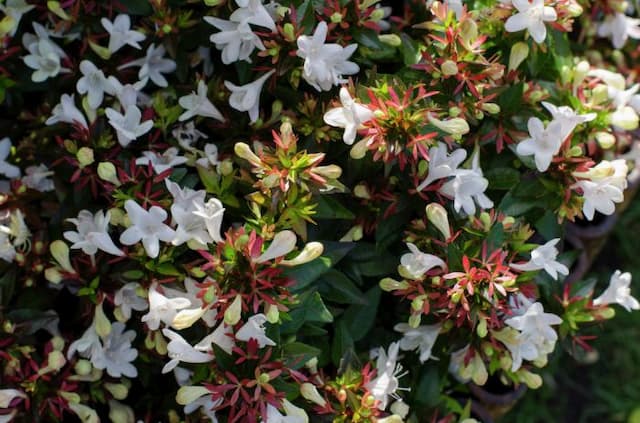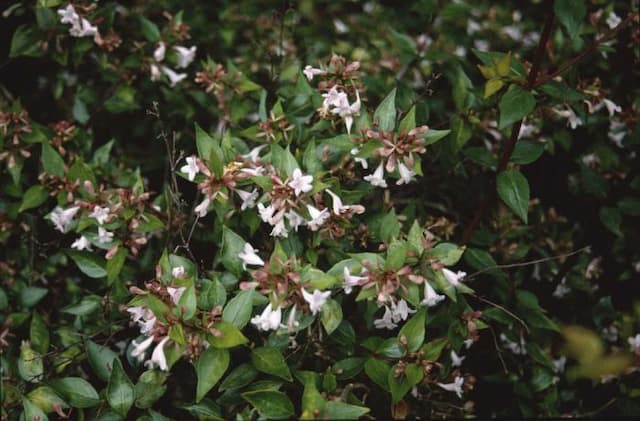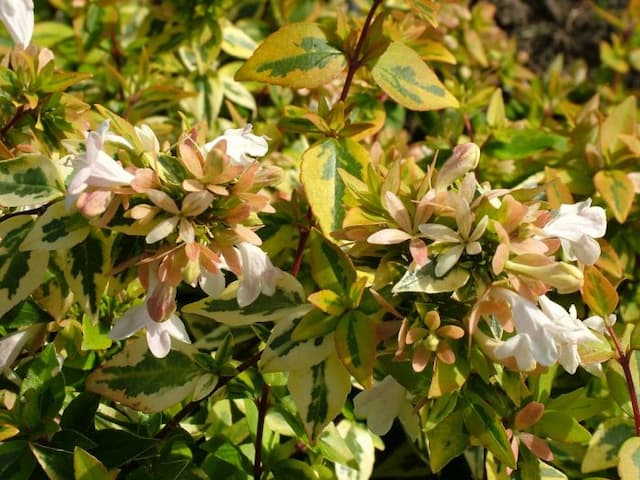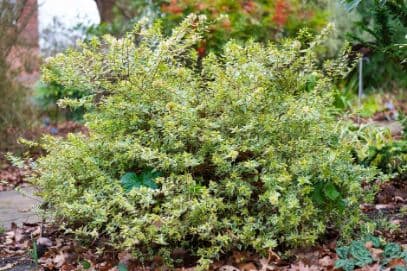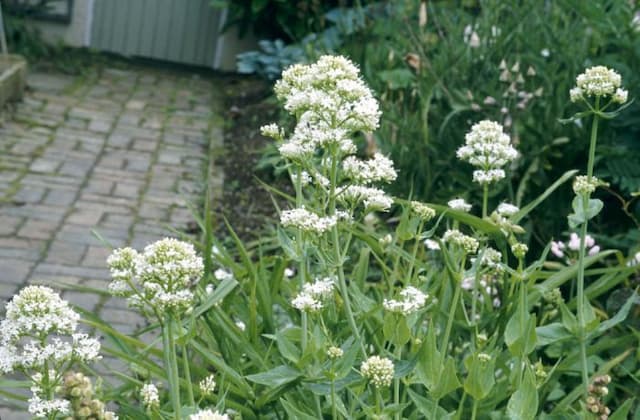Yunnan Honeysuckle Lonicera ligustrina var. yunnanensis 'Maigrün'

ABOUT
The plant known as 'Maigrün' is a variety of honeysuckle characterized by its appealing foliage and the way it showcases its leaves. It has bright green leaves that remain vibrant throughout the growing season, offering a lush backdrop in gardens where it is planted. The leaves are ovate, meaning they are broadly shaped like an egg with a wider base and tapering to the opposite end, and they usually exhibit a glossy texture that can catch the light and add a shimmering effect to the plant's overall appearance. Additionally, this honeysuckle variety produces flowers that can be quite striking. The blossoms typically have a tubular shape, which is a common characteristic of the honeysuckle family, and they are often creamy white or yellow in color. These charming flowers are beloved by gardeners not only for their aesthetic appeal but also for their delightful fragrance, which can enchant the senses when in bloom. While in fruit, the plant can bear berries that provide a contrast to the green foliage. The berries may range in color from red to black, which adds another layer of visual interest to the plant. It is important to note that while the berries can be attractive, they may not be edible and could be toxic if ingested. Overall, 'Maigrün' is a plant that offers year-round interest with its vibrant green leaves, showy and fragrant flowers, and potentially colorful berries. It can serve as an excellent addition to mixed borders, hedges, or as a standalone specimen, contributing to the biodiversity and aesthetic value of a garden space.
About this plant
 Names
NamesFamily
Caprifoliaceae
Synonyms
Maigrün Honeysuckle, Yunnan Box Honeysuckle
Common names
Lonicera ligustrina var. yunnanensis, Lonicera ligustrina f. leucocarpa, Lonicera maackii var. podocarpa, Lonicera yunnanensis.
 Toxicity
ToxicityTo humans
The plant commonly known as Privet, specifically the variety Lonicera ligustrina var. yunnanensis 'Maigrün', can be toxic to humans if ingested. The leaves and berries contain compounds that may cause symptoms such as nausea, vomiting, abdominal pain, diarrhea, and in severe cases may lead to more serious effects such as respiratory difficulty or heart problems. It is advised to avoid ingesting any part of this plant.
To pets
Privet, or Lonicera ligustrina var. yunnanensis 'Maigrün', is also toxic to pets. If a pet ingests parts of this plant, they may exhibit symptoms similar to humans which include vomiting, diarrhea, and abdominal pain. More severe poisoning can lead to lethargy, difficulty breathing, and heart issues. Immediate veterinary attention is recommended if a pet has consumed any part of this plant.
 Characteristics
CharacteristicsLife cycle
Perennials
Foliage type
Deciduous
Color of leaves
Green
Flower color
Cream
Height
6 feet (1.83 meters)
Spread
6 feet (1.83 meters)
Plant type
Shrub
Hardiness zones
5
Native area
China
Benefits
 General Benefits
General Benefits- Aesthetic Appeal: Adds visual interest to gardens with its bright green foliage and yellow-white flowers.
- Wildlife Attraction: Flowers provide nectar for bees and butterflies, while berries offer food for birds.
- Low Maintenance: Typically requires minimal care once established, making it suitable for low-maintenance landscapes.
- Drought Tolerance: Once established, it can tolerate periods of drought, useful in water-conservation gardening.
- Fast Growth: Can quickly grow and cover spaces, which is ideal for creating hedges or privacy screens.
- Soil Adaptability: Adapts to a range of soil types, from clay to loam and sandy soils.
- Shade Tolerance: Capable of growing in partially shaded areas where other plants may struggle.
- Erosion Control: Can be used on slopes and banks to help stabilize soil and prevent erosion.
 Medical Properties
Medical PropertiesThis plant is not used for medical purposes.
 Air-purifying Qualities
Air-purifying QualitiesThis plant is not specifically known for air purifying qualities.
 Other Uses
Other Uses- Lonicera ligustrina var. yunnanensis 'Maigrün', commonly known as the Yunnan border privet, can be used in bonsai creation due to its small leaves and potential for intricate branch structure. Practitioners value it for its adaptability and aesthetic appeal.
- The plant can be incorporated into wildlife gardens to provide shelter and nesting sites for birds, as its dense foliage offers a safe habitat.
- Yunnan border privet can be utilized as a natural screen or hedge in urban areas to create privacy or reduce noise pollution due to its fast growth and dense branching.
- It is used in topiary art; gardeners appreciate its ability to be shaped and maintained in precise forms for ornamental designs.
- The branches and twigs of Yunnan border privet can be harvested and woven into baskets or other forms of natural craftwork.
- Its wood, being fairly firm and fine-grained, is used occasionally for small carving projects or in making wooden inlays and accents in woodworking.
- The Yunnan border privet can be used in urban landscaping to help mitigate soil erosion on slopes thanks to its robust root system.
- Dried and pressed, the leaves of this plant can be used for herbarium collections or botanical studies as representative samples of the species.
- The flowers, while not commonly used in floristry, could provide a unique addition to wildflower arrangements due to their delicate and fragrant nature.
- Leaves of Yunnan border privet can be used in natural dye processes for producing subtle green hues on fabrics, though this is a less-known application.
Interesting Facts
 Feng Shui
Feng ShuiThe plant Lonicera is not used in Feng Shui practice.
 Zodiac Sign Compitability
Zodiac Sign CompitabilityThe plant Lonicera is not used in astrology practice.
 Plant Symbolism
Plant Symbolism- Devotion: Lonicera ligustrina var. yunnanensis 'Maigrün', commonly known as the Box Honeysuckle, often symbolizes devotion due to the entwining nature of its growth, reminiscent of a loving embrace or strong bond.
- Everlasting Bonds: Reflective of the plant's hardy nature and its long-lasting green foliage, Box Honeysuckle represents relationships that endure through time and hardship.
- Generosity: The abundance of its foliage throughout the season can symbolize generosity and the giving of oneself to others.
- Protection: This plant is often used in hedges, which can symbolize protection and the creation of safe boundaries.
- Fraternal Affection: Given its sibling species' tendency to grow in closely knit pairs, Box Honeysuckle can represent brotherly or sisterly love and the closeness between siblings.
 Water
WaterThe Yunnan Privet (Lonicera ligustrina var. yunnanensis 'Maigrün') should be watered when the top inch of soil feels dry to the touch. During active growth in spring and summer, this might be about once a week, but always check the soil moisture before watering. Provide deep waterings to encourage root development, which may require around 1-2 gallons depending on the size of the plant and pot. In winter, reduce watering frequency to prevent waterlogging as the plant's water requirements decrease. Ensure proper drainage to avoid root rot.
 Light
LightThe Yunnan Privet thrives in a position where it can receive full sun to partial shade. A spot that offers morning sunlight and afternoon shade would be ideal to protect the plant from the intense heat of the day. Ensure it gets at least four to six hours of direct sunlight for the best growth and flowering.
 Temperature
TemperatureThe Yunnan Privet can tolerate a broad range of temperatures but grows best in conditions between 50°F and 85°F. It is hardy and can survive minimum temperatures down to around 30°F. Protecting the plant from extreme cold and frost is crucial to avoid damaging the foliage and roots.
 Pruning
PruningPrune the Yunnan Privet to maintain its shape and encourage bushier growth. The best time to prune is late winter or early spring before new growth begins. Pruning can be done annually or as needed to remove dead or overgrown branches to improve air circulation and light penetration throughout the plant.
 Cleaning
CleaningAs needed
 Soil
SoilYunnan Honeysuckle 'Maigrün' thrives in moist, well-draining soil, rich in organic matter. The soil pH should be slightly acidic to neutral, ranging from 6.0 to 7.0 for optimal growth. A mix of loam, peat, and sand is often recommended to provide the necessary drainage and fertility.
 Repotting
RepottingYunnan Honeysuckle 'Maigrün' should generally be repotted every two to three years to prevent root bounding and to refresh the soil. Younger, more vigorously growing plants may require more frequent repotting.
 Humidity & Misting
Humidity & MistingYunnan Honeysuckle 'Maigrün' prefers moderate to high humidity levels, generally around 60-80%. Consistent humidity is key to keeping this plant healthy, without fluctuations that could stress the plant.
 Suitable locations
Suitable locationsIndoor
Place in bright, indirect light; ensure moderate humidity.
Outdoor
Plant in partial shade; protect from strong winds.
Hardiness zone
6-9 USDA
 Life cycle
Life cycleLonicera ligustrina var. yunnanensis 'Maigrün', commonly known as the Yunnan Honeysuckle or 'Maigrün' Bush Honeysuckle, begins life as a seed, which after stratification, germinates in spring when the soil temperatures are favorable. The seedling stage follows, where roots and shoots develop; during this stage, it is crucial for the plant to receive adequate light and water. As it matures into a juvenile plant, it develops a more robust root system and foliage, gradually forming into a bushy shrub with characteristic green leaves. Flowering typically occurs in late spring to early summer, presenting small, fragrant flowers that attract various pollinators. After pollination, the flowers develop into berries, which ripen and are dispersed by birds and other wildlife, facilitating the spread of seeds. Finally, the plant reaches senescence, where growth slows and, depending on environmental conditions, it may die back in winter or continue to maintain its leaves if the climate is mild, completing its perennial life cycle.
 Propogation
PropogationPropogation time
Spring
The Lonicera ligustrina var. yunnanensis 'Maigrün', commonly known as the Yunnan Honeysuckle, is typically propagated by softwood cuttings taken in late spring or early summer when the new growth is just hardening and still has a green, flexible base. To do this, a cutting about 4-6 inches (10-15 cm) long is snipped from the parent plant. The lower leaves are then stripped off, and the cut end is dipped into a rooting hormone powder or solution to encourage root development. The prepared cutting is placed in a pot filled with a mix of peat and perlite or sand to provide good drainage and aeration. The cutting should be kept in a warm, humid environment with indirect light. It is important to maintain consistent moisture in the soil, but not to the point of waterlogging. Roots usually develop within a few weeks, after which the young plants can be potted on or gradually acclimatized to outdoor conditions.
